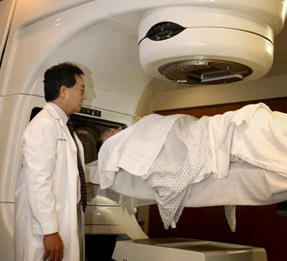Facts About Gynecologic Cancers
Gynecologic cancers include malignancies of the female genital tract involving the vulva, vagina, cervix, uterus, Fallopian tubes or ovaries.
- According to the American Cancer Society, nearly 80,000 women per year are diagnosed with some form of gynecologic cancer.
- The three most common gynecologic cancers are uterine, cervical and ovarian, accounting for more than 73,000 new diagnoses each year.
- Widespread screening with the Pap test has allowed doctors to find pre-cancerous changes in the cervix and vagina. This has helped catch some invasive cancers early.
Treatment Options for Gynecologic Cancers
Treatment for gynecologic cancers depends on several factors, including the type of cancer, its extent (stage), its location and your overall health. It is important to talk with several cancer specialists before deciding on the best treatment for you, your cancer and your lifestyle.
- A gynecologic oncologist is a doctor who specializes in surgically removing gynecologic cancers. A gynecologic oncologist may also oversee your chemotherapy treatment.
- A radiation oncologist is a doctor specially trained to treat cancer with radiation therapy.
- A medical oncologist is a doctor who specializes in treating cancer with drugs (chemotherapy).
Sometimes, your cancer may be treated by using only one type of treatment. In other cases, your cancer may be best cured using a combination of surgery, radiation therapy and chemotherapy.
Understanding Radiation Therapy
Radiation therapy, sometimes called radiotherapy, is the careful use of radiation to safely and effectively treat cancer.
- Radiation oncologists use radiation therapy to try to cure cancer, to control cancer growth or to relieve symptoms, such as pain.
- Radiation therapy works within cancer cells by damaging their ability to multiply. When these cells die, the body naturally eliminates them.
- Healthy tissues are also affected by radiation, but they are able to repair themselves in a way cancer cells cannot.
Types of Radiation Therapy
There are two types of radiation therapy.
- External beam radiation therapy delivers treatment from a machine outside your body.
- Internal radiation therapy, or brachytherapy, delivers treatment using radioactive sources placed into the vagina, uterus and/or surrounding tissues to kill the cancer cells.
External Beam Radiation Therapy
External beam radiation therapy involves a series of daily outpatient treatments to deliver radiation to the cancer accurately. Treatments are painless and are similar to getting an X-ray. They are usually given in a series of daily sessions, each taking less than half an hour, Monday through Friday, for five to six weeks.
- Three-dimensional conformal radiotherapy (3D-CRT) combines multiple radiation treatment fields to deliver precise doses of radiation to the affected area. Tailoring each of the radiation beams to focus on the tumor delivers a high dose of radiation to the tumor and avoids nearby healthy tissue.
- Intensity modulated radiation therapy (IMRT) is the most recent advance in the delivery of radiation. IMRT improves on 3D-CRT by modifying the intensity of the radiation within each of the radiation beams. This allows more precise adjustment of radiation doses to the tissues within the target area.
Internal Radiation Therapy
Internal radiation therapy (also called internal or intracavitary radiotherapy, or brachytherapy) involves placing radioactive sources in or next to the cancer. This is usually done at the same time or after external beam radiation therapy to achieve the best results. Brachytherapy is very important in the treatment of vaginal, cervical and uterine cancers.
There are two types of brachytherapy:
- Low-dose-rate brachytherapy is delivered over the course of 48 to 72 hours. You will be admitted into the hospital to receive this treatment.
- High-dose-rate brachytherapy does not usually require you to be admitted to the hospital. The entire procedure typically takes a few hours. In some simple cases, treatment can take less than an hour.
Depending of the type of cancer you have, you may need to have several sessions of brachytherapy to treat your cancer.
Potential Side Effects
The side effects you may experience will depend on the area being treated and the type of radiation used. Before treatment, ask your doctor to describe what you can expect.
- Some patients experience minor or no side effects and can continue their normal routines.
- Some patients may notice nausea, fatigue, skin irritation, vaginal irritation and discharge, frequent urination, burning with urination, and diarrhea. These will all resolve after treatment ends.
- Some time after your treatment, you may see minor changes to your bowel, bladder or vagina. Radiation may cause the vagina to be drier and less flexible. Ask your doctor or nurse how to manage these changes.
- You may have additional side effects if you are receiving chemotherapy at the same time as radiation therapy.
- If at any time you develop side effects, tell your doctor or nurse. He or she can give you medicine to help.
Caring for Yourself During Treatment
- Get plenty of rest during treatment, and don’t be afraid to ask friends and family for help.
- Follow your doctor’s orders. Ask if you are unsure about anything or if you have questions about your treatments and side effects.
- Tell your doctor about any medications or vitamins you are taking, to make sure they’re safe to use during radiation therapy.
- Eat a balanced diet. If food tastes funny or you’re having trouble eating, tell your doctor or dietician. They may be able to help you change the way you eat.
- Carefully treat the skin exposed to radiation. Avoid hot or cold packs, and only use lotions and ointments after checking with your doctor or nurse.
- Clean the area with mild soap and water. Apply ointments only as directed by your doctor or nurse.
- Dealing with cancer and cancer treatment is difficult. Family, friends, support groups and your oncology team can be helpful during this time.
To order hard copies of this brochure, visit the ASTRO Shop.
